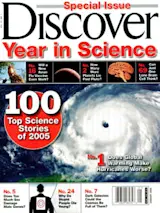Dolphins' Daughters Sponge for Knowledge
Scientists tracking dolphin behavior reported in June that the mothers pass tool use on to their female offspring. Researchers found that bottlenose dolphins share knowledge of how to use marine sponges for foraging, reflecting a combination of tool use and social learning.
The dolphins wear the conical tools on their nose, or rostrum, although no one knows yet how this helps them feed, says Michael Krützen, an evolutionary geneticist who coauthored the study. Krützen, a postdoctoral student at the University of New South Wales when the discovery was made, said he and his colleagues found that sponge users in Western Australia have a different diet from their pod mates. That suggests the tools let them gain access to a new food source, perhaps by protecting their rostrums as they sift the seafloor for bottom dwellers. The technique is not genetically imprinted, like nest building, and ...














